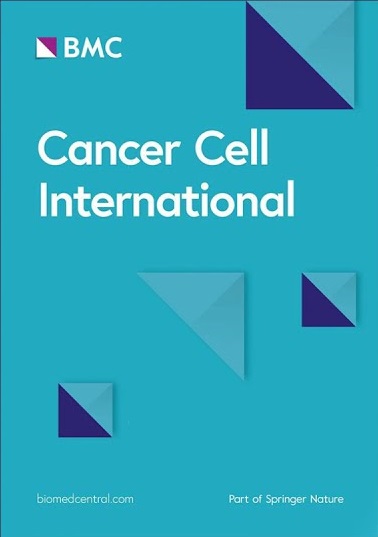Long-term zinc treatment alters the mechanical properties and metabolism of prostate cancer cells
IF 5.3
2区 医学
Q1 ONCOLOGY
引用次数: 0
Abstract
The failure of intracellular zinc accumulation is a key process in prostate carcinogenesis. Although prostate cancer cells can accumulate zinc after long-term exposure, chronic zinc oversupply may accelerate prostate carcinogenesis or chemoresistance. Because cancer progression is associated with energetically demanding cytoskeletal rearrangements, we investigated the effect of long-term zinc presence on biophysical parameters, ATP production, and EMT characteristics of two prostate cancer cell lines (PC-3, 22Rv1). Prolonged exposure to zinc increased ATP production, spare respiratory capacity, and induced a response in PC-3 cells, characterized by remodeling of vimentin and a shift of cell dry mass density and caveolin-1 to the perinuclear region. This zinc-induced remodeling correlated with a greater tendency to maintain actin architecture despite inhibition of actin polymerization by cytochalasin. Zinc partially restored epithelial characteristics in PC-3 cells by decreasing vimentin expression and increasing E-cadherin. Nevertheless, the expression of E-cadherin remained lower than that observed in predominantly oxidative, low-invasive 22Rv1 cells. Following long-term zinc exposure, we observed an increase in cell stiffness associated with an increased refractive index in the perinuclear region and an increased mitochondrial content. The findings of the computational simulations indicate that the mechanical response cannot be attributed exclusively to alterations in cytoskeletal composition. This observation suggests the potential involvement of an additional, as yet unidentified, mechanical contributor. These findings indicate that long-term zinc exposure alters a group of cellular parameters towards an invasive phenotype, including an increase in mitochondrial number, ATP production, and cytochalasin resistance. Ultimately, these alterations are manifested in the biomechanical properties of the cells.长期锌处理可改变前列腺癌细胞的机械特性和新陈代谢
细胞内锌积累失败是前列腺癌发生的一个关键过程。虽然前列腺癌细胞在长期接触锌后可以积累锌,但长期锌过量供应可能会加速前列腺癌的发生或化疗耐药性。由于癌症进展与高能量的细胞骨架重排有关,我们研究了锌的长期存在对两种前列腺癌细胞系(PC-3、22Rv1)的生物物理参数、ATP生成和EMT特征的影响。长期接触锌会增加 ATP 的产生、剩余呼吸能力,并诱导 PC-3 细胞产生反应,其特征是波形蛋白重塑、细胞干物质密度和洞穴素-1 转移到核周区域。这种锌诱导的重塑与维持肌动蛋白结构的更大趋势相关,尽管细胞松抑制了肌动蛋白的聚合。锌通过减少波形蛋白的表达和增加 E-cadherin,部分恢复了 PC-3 细胞的上皮特征。尽管如此,E-cadherin 的表达仍然低于在以氧化为主的低侵袭性 22Rv1 细胞中观察到的表达。长期锌暴露后,我们观察到细胞硬度增加,这与核周折射率增加和线粒体含量增加有关。计算模拟的结果表明,机械反应不能完全归因于细胞骨架组成的改变。这一观察结果表明,还有一种尚未确定的机械因素可能参与其中。这些研究结果表明,长期锌暴露会改变一组细胞参数,使其趋向侵袭性表型,包括线粒体数量、ATP 产量和细胞松素抗性的增加。这些改变最终体现在细胞的生物力学特性上。
本文章由计算机程序翻译,如有差异,请以英文原文为准。
求助全文
约1分钟内获得全文
求助全文
来源期刊

Cancer Cell International
ONCOLOGY-
CiteScore
10.90
自引率
1.70%
发文量
360
审稿时长
1 months
期刊介绍:
Cancer Cell International publishes articles on all aspects of cancer cell biology, originating largely from, but not limited to, work using cell culture techniques.
The journal focuses on novel cancer studies reporting data from biological experiments performed on cells grown in vitro, in two- or three-dimensional systems, and/or in vivo (animal experiments). These types of experiments have provided crucial data in many fields, from cell proliferation and transformation, to epithelial-mesenchymal interaction, to apoptosis, and host immune response to tumors.
Cancer Cell International also considers articles that focus on novel technologies or novel pathways in molecular analysis and on epidemiological studies that may affect patient care, as well as articles reporting translational cancer research studies where in vitro discoveries are bridged to the clinic. As such, the journal is interested in laboratory and animal studies reporting on novel biomarkers of tumor progression and response to therapy and on their applicability to human cancers.
 求助内容:
求助内容: 应助结果提醒方式:
应助结果提醒方式:


